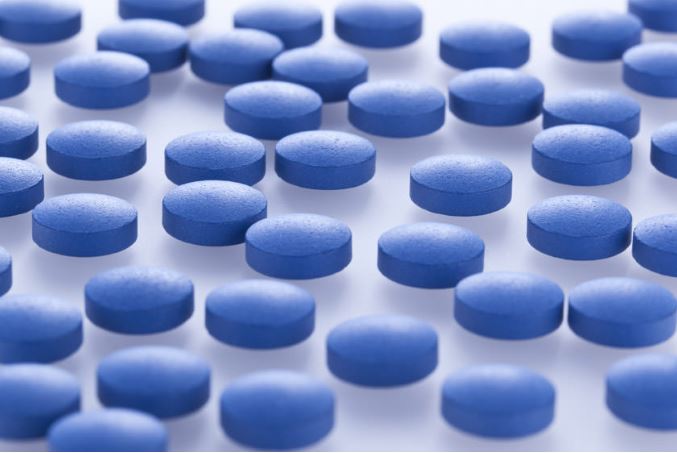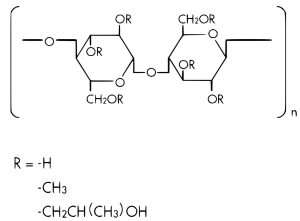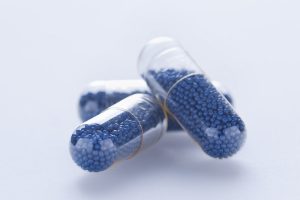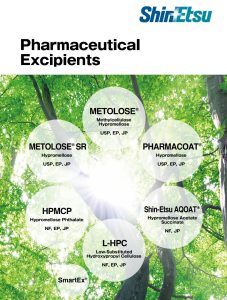PHARMACOAT® – Easy to use film coating material that provides an excellent finish

Shin-Etsu Chemical supplies the various excipients for pharmaceutical industry and developed PHARMACOAT® in the 1960s during the early days of film coating and since then it has been the subject of a continuous development and quality improvement.
The PHARMACOAT® grades are low viscous hypromellose substitution 2910 (also named as Hydroxy propyl methyl cellulose or HPMC). Hydroxypropoxy and methoxy groups are introduced on the cellulose backbone, resulting in a water-soluble cellulose derivative.
Several viscosity grades are available as shown in the table below and are compliant with the pharmacopoeias from USA, Japan and Europe.
PHARMACOAT®
The tablet coating using hypromellose became popular because it is an easy method to protect fragile tablets and provide a smooth surface of the coated tablets. Another advantage for the extensive use of PHARMACOAT® in coating applications is its solubility over the entire biological pH.

One of the main advantages using PHARMACOAT® grades in tablet or pellet coating is the ability of hypromellose to form transparent and flexible films from aqueous solutions.
PHARMACOAT® 606 is the most used grade for tablet coating, in case of fragile tablets, PHARMACOAT® 615 is recommended. On the other hand, PHARMACOAT® 603 is the preferable grade for pellet coating. Low viscous hydroxyl propyl methyl cellulose grades are also one of the major products used for capsules coating or capsules banding. The aim of this application is to seal the gap existing between the two parts of the capsules in order to avoid any liquid penetration.
In order to easy differentiated from each other oral solid dosage forms having the same shape, pigments can be added to the hypromellose film solutions. In that case, the film flexibility is decreased, for that reason we recommend to add plasticizers in the coating formulation. Furthermore, talc can be added to the coating formulation to optimise tablets slipping during the packaging or reduce the tackiness of tablets and pellets during the coating process.
Film coating agent, binder

Features:
- Low viscosity, suitable for film coating with water or solvent (co-solvent of water and ethanol) coating system.
- Water soluble and non-ionic, less interaction with active pharmaceutical ingredient (API).
- Applicable as a binder in wet granulation. Low viscosity and soluble polymer, helpful to obtain granules with uniform particle size and good flowability.
- Applicable also as a solid dispersion carrier.
PHARMACOAT® as binder for wet granulation
Hydroxy propyl methyl cellulose is an effective and widely used binder in wet granulation processes. It has superior stability due to its non-ionic character, and hence it does not interact with drugs. PHARMACOAT® 603 or 606 are used either in dry form or in the binding solution. Both are used in typical wet granulation processes like fluid bed granulation or high shear granulation. The obtained granules show an improved flow property compared to the initial powder. They can then be compressed into tablets or filled into capsules or directly into sachets.
PHARMACOAT® used as capsule shell

Hydroxy propyl methyl cellulose films show as well interesting properties for the manufacturing of hard capsules. Thus, low viscosity hypromellose is used to replace gelatine in this application. The main advantages over gelatine are the better moisture stability as hypromellose is less moisture sensitive and its plant derived origin. The optimal solution for patients who follow a vegetarian or vegan diet.
Shin-Etsu has around 20 Technical documents available regarding Hydroxy propyl methyl Cellulose for coating applications; such as:
• Solubility of PHARMACOAT® 606 in Alcohol-Water Mixtures
• Effect of Plasticizers and other Additives on the mechanical properties of cast Hypromellose Films
• among others…
See the full brochure on “Pharmaceutical Excipients by Shin-Etsu” here
(find more on PHARMACOAT® on page 1, click the picture to download the brochure)
Source: Shin-Etsu, brochure “Pharmaceutical Excipients by Shin-Etsu”


